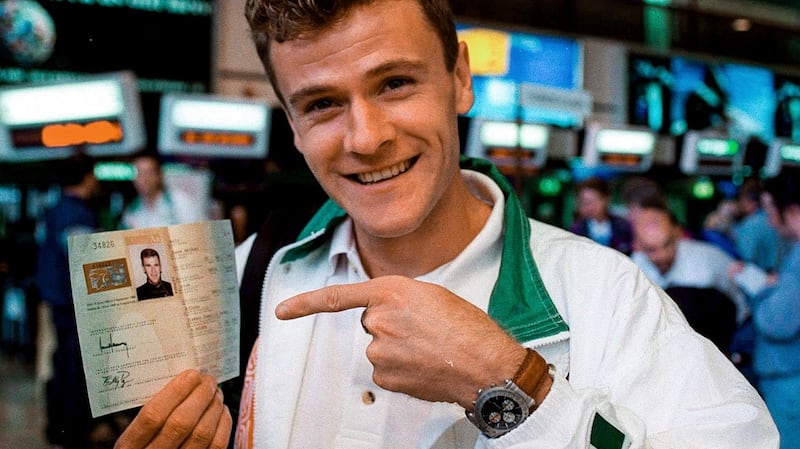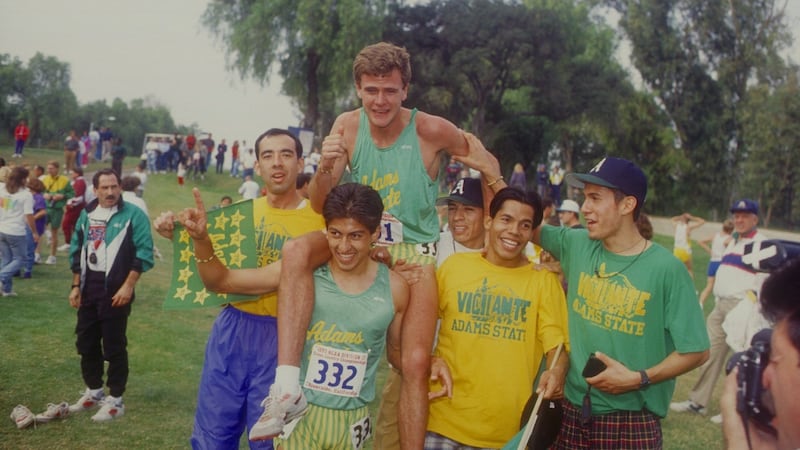“Are you the Shane Healy?”
We were outside some bar on Leeson Street, on the way to some nightclub, on a night somewhere late in the summer of 1997. I knew who he was and just wanted to make sure because even then there was something exuberant and wild and utterly different about the running life of Shane Healy.
He’d a couple more years on me and that’s all. I wasn’t long home from America after a couple of years bumming around after college, still trying to make it as a distance runner, and he wasn’t long home from running the 1,500m at the World Championships in Athens, having also made the semi-finals at the 1996 Olympics in Atlanta the summer before.
We met a few times around that period, in part because Healy seemed to know some of the same people I did, including my older brother. That was part of his charm, he seemed to know everyone, especially every bouncer in Dublin, and he was always engaging company, and encouraging, even though we actually shared precious little in common – not least the fact he didn’t touch alcohol, happy to get his kicks by simply being out mixing with different people.
I also knew his story of making those 1996 Olympics in Atlanta was part chance, part fairytale, part luck, and against all the odds. Of the many unlikely backgrounds of Irish Olympians over the century, his possibly sits as the most daring among them. Because much of his early life was spent running away from something, sometimes the threat of violence or abuse, sometimes trouble of his own making, and it was only after chasing the American dream that Healy first stepped foot onto a running track, at the age of 21.

Fearless pursuit
Just five years later, he was competing on the biggest stage of all, in the blue ribband event. Around that time too I would sometimes look at Healy’s running life and think if he could make that kind of standard then anyone could. Which of course is both inaccurate and unfair: there is nothing more common in sport than wasted talent, particularly in the sport of athletics, and what ultimately set Healy apart was his fearless pursuit of whatever bit of talent he had and gutsy determination to make the absolute most of it - which better still he continues to do at the age of 51.
Given the increasing uncertainty and perhaps appetite for Tokyo, his running life is also about the lasting pull and power of the Olympics, a timely reminder of which comes with him being the subject of this weekend’s RTÉ Documentary On One, Shane Healy - Back on Track. Not simply a reflection on his running life, and some of the dark times that came with it, it’s as much about how Healy continues to infuse the sport with his knowledge and experience by training and competing with the Dublin Track Club, still being utterly different.
It’s a reminder too that were it not for some freak turn of events, Healy’s life still seems predestined to be an entirely different one, possibly a shorter one too. Born into a family of discontent, his mother left the family home in Roscommon when he was four, along with his older sister, and when his father left for England he found himself in and out of orphanages in Dublin, including the notorious Goldenbridge, in Inchicore.
He left formal education at age 13, tried his hands in various pursuits, not all legal, before landing a job at the Headline Bar, at Leonard’s Corner, where a chance meeting with an American couple, Ryan and Sheri Roberts, ended with an invitation to visit them in Tampa, Florida, should he ever be passing.
At age 18, Healy took that as destiny calling, and so began an American adventure that was more Kerouac and Burroughs than Whitman and Fitzgerald, and which later landed him at Contra Costa Community College, near San Francisco. It was here the running coach reckoned he might have the next Eamonn Coghlan or Marcus O’Sullivan, neither of whom Healy had even heard of, and so dared him €50 to run a mile around the track.

After that Healy quickly progressed to Adams State University, in Alamosa, Colorado, winning the American Division 2 cross country, and setting up a shot at the Olympics: in his own inimitable way he then persuaded Coghlan to coach him, and more pertinently persuaded the meeting organiser in Madrid, his last chance to qualify for Atlanta, to give him a lane in the 1,500m. In the not insignificant attitude, and searing heat, Healy ran 3:36.58: the next time his passport was stamped it was on entry to Atlanta, where he ran 3:37.28 to make the semi-finals, completing that perfect chapter of his running life.
Financial crash
Despite improving again to 3:35.29 in 1997, still the seventh fastest Irishman in history, he soon fell away from the sport, not helped by a back injury, and turned his energy elsewhere, including a classic car business run from his home in Laytown, in Meath. When the financial crash of 2008 wiped that business out, took away his home too, his running life took another turn.
He retrained as a carer, now serving with the National Association of Housing for the Visually Impaired, and around the same time a desire to improve his own mental and physical health drew him back to the sport that had served him so well. As if destiny came calling again, he’s found that with the Dublin Track Club, designed to improve the health of Irish distance running, where he’s also set a series of over-50 world records.
There are parts of his running life you couldn’t make up, other parts he’s perhaps careful to conceal, Healy’s dare to be an Olympian all the more compellingly documented when set against his lifelong running quest to find his mother and sister, neither of whom have been seen or heard of in the 47 years since they ran away.
The RTÉ Documentary On One Shane Healy - Back on Track goes out on Radio 1 this Saturday (1pm), repeated on Sunday (7pm), and is also available as an RTÉ podcast.













